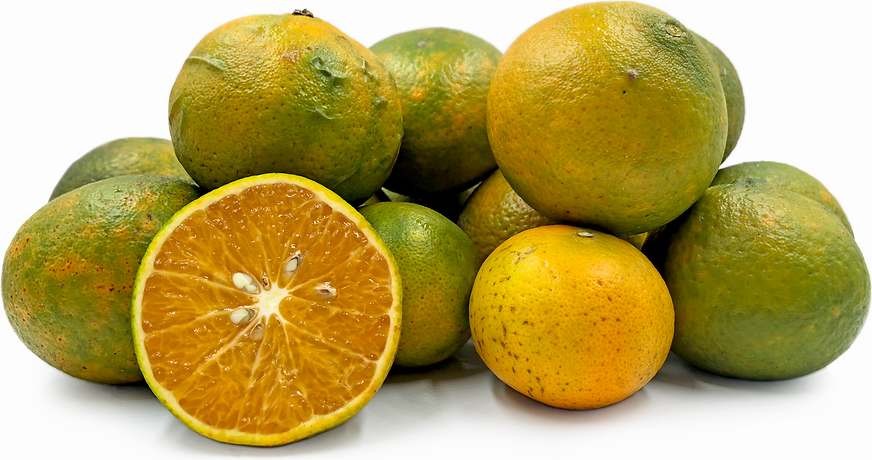


Tahitian Oranges
Estimated Inventory, lb : 0
Description/Taste
Tahitian oranges are small fruits, averaging 5 to 10 centimeters in diameter, and have a globular, oval, to slightly flattened shape. The rind is semi-smooth and thin, covered in many pores forming shallow indentations, and ripens from green to yellow-orange when mature. Underneath the surface, the flesh is soft, orange to pale yellow, aqueous, divided into 8 to 11 segments by thin white membranes, and contains a few to several small seeds. Tahitian oranges are aromatic and have a very sweet, musky, and subtly earthy flavor with low acidity.
Seasons/Availability
Tahitian oranges are available in the winter through early spring.
Current Facts
Tahitian oranges, botanically classified as Citrus x limonia var. Otaheite, are a sweet variety that belongs to the Rutaceae family. Oranges are a highly prized fruit in Tahiti and are considered to be very rare as they are only hand-harvested from a few remaining wild trees once a year. Tahitian oranges are also known as Otaheite oranges, which is another older name for the island of Tahiti. The variety is believed to be a descendant of the rangpur lime, which is a cross between a mandarin and a lemon, but despite its tart origins, Tahitian oranges are unique as they contain low acidity, giving the fruits a much sweeter flavor for fresh consumption.
Nutritional Value
Tahitian oranges are an excellent source of vitamin C, which is an antioxidant that protects the body against environmental aggressors by boosting the immune system. The fruits also contain potassium, which can help regulate fluid levels, and provide smaller amounts of phosphorus and calcium.
Applications
Tahitian oranges are best suited for raw applications as their sweet, juicy flesh is showcased when consumed fresh, out-of-hand. The rind is easily peeled from the flesh, and the flesh can be eaten as a snack, tossed into fruit salads and green salads, or used as a fresh topping over desserts. Tahitian oranges are also popularly juiced and mixed with local honey as a sweet drink, blended into smoothies, or stirred into fruit punch. In addition to fresh applications, the juice of Tahitian oranges can be used to flavor stir-fries, curries, and soups, or the fruits can be used whole and stuffed into pigs for roasting over open fires. The flesh is also sometimes used in baked goods such as cakes and tarts and is sliced and caramelized as a sweet, savory topping over ice cream. Tahitian oranges pair well with meats such as pork, poultry, and fish, crabs, shrimp, fruits such as breadfruit, bananas, mangoes, papaya, and pineapples, coconut milk, and taro leaves. The fresh fruits will keep 2-4 weeks when stored in the refrigerator.
Ethnic/Cultural Info
In Tahiti, wild Tahitian oranges are primarily found in the valleys and mountainous plateaus of Punaruu along the western coast. The oranges are only harvested once a year to protect the native ecosystem, and when it’s time for the harvest, the Punaruu people gather together to host a local festival in honor of the fruit. The trail up to the most popular plateau, locally known as Tamanu or the “plateau of oranges,” takes two days to clear by hand with machetes, and men from the village then hike over eight hours to reach the orange trees growing at elevations above 609 meters. The hike is physically demanding, and experienced harvesters place the fruits in large sacks on bamboo poles and carry the fruits on their shoulders back down to the village. It is considered a great honor to be able to harvest the oranges, and the location of the best wild orange trees are kept a secret. During the local festival, traditional dances and sports such as outrigger canoeing and stone-lifting are also performed as a form of entertainment.
Geography/History
Tahitian oranges are descendants of rangpur limes that were originally native to India. The limes were introduced into Tahiti through East Asian explorers during ancient times, and once naturalized, the fruits quickly spread in popularity across the island where they were grown for export in the 1800s. Tahiti remained a central hub for citrus production, exporting both fruits and small trees to Europe in the early 1800s and the United States in the late 1800s, but disease and insects almost entirely wiped the trees from the island in the early 1900s. Today there are only a few remaining wild orange trees in the Punaruu region, and the hand-harvested fruits are sold alongside roadsides at small stands or are sold in select markets such as the central market in Papeete.




